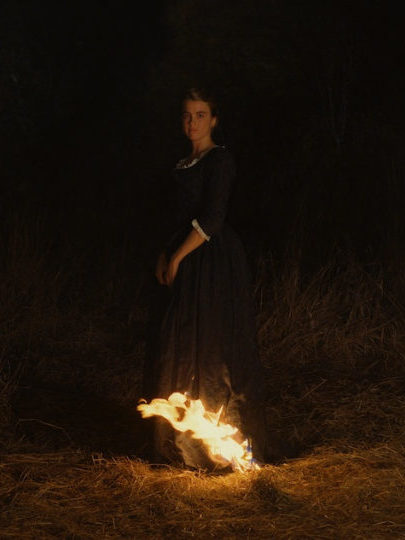“PORTRAIT OF A LADY ON FIRE” BURNS IN ALL THE RIGHT WAYS

In her stirring 2019 period romance Portrait of a Lady on Fire, director Céline Sciamma tells a bittersweet tale of love and love denied. Dreamy, yet woefully disillusioned, the French film focuses on the idea of art as a means of revealing one’s true self. More specifically, it leaves the audience ruminating on the idea that passion is to art as forbidden love is to the inevitable heartbreak of reality. It’s a slow-burning, resolute account of a lesbian romance defying the expectations of the patriarchal eighteenth-century elite, one the audience knows is doomed from the beginning. With its deliberate pace, subtitles, and minimal bodice-ripping sex scenes, the film can understandably be hard to access for many period romance enthusiasts. That being said, the feelings of love and possibility that the two main characters experience together serve to capture the audience’s imagination despite knowing their fate. As such, I found myself enthralled for all of its two hours and truly appreciated this unique romance told through a female gaze.
The film opens and we meet a world-weary art teacher named Marianne as she recounts to her students, seemingly for the first time, the story behind one of her particularly striking paintings. We are swept away to the coast of 1770s Brittany, where Marianne has been commissioned to paint Héloïse, a young woman of the gentry set to marry a nobleman. Despite the patriarchal customs that define their lives, the two women experience an instant connection that is both delicate and dazzling.
Creating a female protagonist that is a diegetic storyteller and a rich character with wants, needs, and flaws, Sciamma presents a complex lesbian relationship rather than the spectacle we so often see in Hollywood. Marianne exposes the sheltered Héloïse to the beauty of art and music, brilliantly echoing the nascent excitement and wonder of a first sexual experience. The film is thoroughly erotic without relying on overly long and explicit sex scenes, à la Abdellatif Kechiche’s 2013 Blue Is The Warmest Color.
As the story unfolds, art is the mirror and the catalyst of their passion, with each thoughtful frame a masterpiece in its own right. Claire Mathon’s cinematography is nothing less than stunning, all sweeping, jagged landscapes and a moody color palette of soft blues and earth tones. The focus on the growing bond between the two women is as striking and daunting as the rugged coastline beaches upon which their first frangible connection was formed. Vibrant, painterly hues accentuate themes of art and beauty. Even the lighting is strategic, with objects, characters, and clothes appearing both shadowed and luminescent, creating a sense of surrealism.

Portrait of a Lady on Fire gives “I burn, I pine, I perish” a whole new meaning. Fire as consuming desire plays powerfully against the stark, watery backdrop. Both an agent of passion and destruction, the use of fire as a theme reminds the viewer that their passion is ever-present as well as a barely suppressed chaos. Unrealized passions burn, figuratively and literally, when they attend an all-female bonfire and Héloïse’s dress catches on fire. This is the turning point, the image that would stay with Marianne forever. With the first commissioned, parent-approved, and predictably pellucid portrait completed (and destroyed), this moment would go on to inspire the true painting of Héloïse, a portrait of a lady on fire.
When the tension breaks and the women finally acknowledge their feelings, the viewer feels their relief; it is the climax of the film in more ways than one. Of course, in keeping with its realisticness, their happiness is short-lived. Yet I found the film’s end to be tinged in hope and love, and it left me distinctly satisfied. I was reminded of Luca Guadagnino ’s Call Me By Your Name and Jane Campion’s The Piano, both of which examine themes of pining and love denied. With the former’s tragic theme of societally forbidden love and the latter’s aesthetic and stormy female desire, Portrait of a Lady on Fire sits perfectly in between them. However, part of what makes this film wholly unique is that it does not focus on the forces that draw the lovers apart from each other the way that other movies of its ilk might. Rather, it lingers on the idea of love briefly experienced.
Noémie Merlant and Adèle Haenel’s powerful and nuanced performances lend the film the intensity it needs to make their sexual tension an unseen, third main character. Sciamma hones in on this tension throughout the film, not only between the two characters, but between the characters and the audience, the voyeurs of this real and intimate relationship. Indeed, tension and self-denial dictate the way the movie was made to its very bones. Portrait of a Lady on Fire is an astounding exercise in restraint, with limited dialogue and sparing music used only in pointed moments of art and passion. In what she doesn’t show, in what the characters don’t say, Sciamma paints a picture much like Marianne’s– a picture of sorrow and passion, but also of feminine strength and resilience.







Leave a Comment